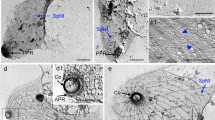Abstract
The immunological cross-reactivity of the protein from whole-cell extracts ofToxoplasma gondii with antisera against actins from chickengizzard smooth muscle and fromAscaris body-wall muscle was demonstrated by sodium dodecyl sulfate-polyacrylamide slab gel electrophoresis (SDS-PAGE) and immunofluorescence studies. A protein of about 42 kDa, with the same mobility as that of rabbit smooth-muscle actin in SDS-PAGE showed cross-reactivity with anti-actin antisera on the electroblotted nitrocellulose sheet. Indirect fluorescent antibody staining of the parasites clearly showed that actin localized strongly in the anterior third of the organism in both extra- and intrahost cellular stages. From both a biochemical as well as structural point of view, the results obtained in the present experiments might explain the locomotive features of the parasite such as twirling and sliding, with most of the activity at the anterior end.
Similar content being viewed by others
References
Bommer W, Hofling KD, Heunert HH (1969) Multiplication ofToxoplasma gondii in cell cultures. Ger Med Monthly 14:399–405
Chiappino ML, Nichols BA, O'Connor G (1984) Scanning electron microscopy ofToxoplasma gondii: parasite torsion and host cell responses during invasion. J Protozool 31:288–291
Cintra WM, De Souza W (1985) Immunocytochemical localization of cytoskeletal proteins and electron microscopy of detergent extracted tachyzoites ofToxoplasma gondii. J Submicrosc Cytol 17:503–508
Endo T, Tokuda H, Yagita K, Koyama T (1987) Effects of extracellular potassium on acid release and motility initiation inToxoplasma gondii. J Protozool 34:291–295
Doran DJ (1972) Cultivation of coccidia in avian embryos and cell culture. In: Hammond DM, Long PL (eds) The coccidia. University Park Press, Baltimore, pp 183–252
Jacobs L (1953) The biology ofToxoplasma. Am J Trop Med Hyg 2:365–389
Kelley GL, Hammond DM (1967) Development ofEimeria ninakohlyakimonae from sheep in cell cultures. J Protozool 17:340–349
Mühlpfordt H (1952) Das Verhalten vonToxoplasma gondii Stam BK in der Gewebekulturen. Z Tropenmed Parasitol 4:53–64
Nakamura T, Yanagisawa T, Yamaguchi M (1975) Studies on the subunits of myosin from muscle layer ofAscaris lumbricoides suum. Biochim Biophys Acta 412:229–240
Nakamura T, Yamaguchi M, Yanagisawa T (1979) Comparative studies on actins from various source. J Biochem 8:627–631
Nichols BA, Chiappino ML (1987) Cytoskeleton ofToxoplasma gondii. J Protozool 34:217–226
Nichols BA, O'Connor GR (1981) Penetration of mouse peritoneal macrophages by the protozoonToxoplasma gondii. New evidence for active invasion and phagocytosis. Lab Invest 44:324–335
Nishioka M, Watanabe S, Kobayashi K, Nakamura T (1983) Rabbit autoantibodies to actin induced by immunization with heterologous actins; a possible mechanisms of smooth muscle antibody production. Clin Exp Immunol 5:159–164
Pulvertaft RJ, Valentine JC, Lane WF (1954) The behavior ofToxoplasma gondii on serum-agar culture. Parasiology 44:478–485
Russel DG, Sinden RE (1981) The role of the cytoskeleton in the motility of coccidian sporozoites. J Cell Sci 50:345–359
Ryning FW, Remington JS (1978) Effect of cytochalasin D onToxoplasma gondii cell entry. Infect Immun 20:739–743
Sampson JR, Hammond DM, Ernst JV (1971) Development ofEimeria alabamensis from cattle in mammalian cell cultures. J Protozool 18:120–128
Schwartzman JD, Pfefferkorn ER (1983) Immunofluorescent localization of myosin at the anterior pole of the coccidian,Toxoplasma gondii. J Protozool 39:657–661
Sheffield HG, Melton ML (1968) The fine structure and reporduction ofToxoplasma gondii. J Parasitol 54:209–226
Sourander P, Lycke E, Lund E (1960) Observations of living cells infected withToxoplasma gondii. Br J Exp Pathol 41:176–178
Spudich JA (1974) Biochemical and structural studies on actomyosin-like proteins from non-muscle cells. J Biol Chem 249:6013–6020
Towbin H, Staehelin T, Gordon J (1979) Electrophoretic transfer of proteins from polyacrylamide gels to nitrocellulose sheets: procedure and some applications. Proc Natl Acad Sci USA 76:4350–4354
Trechev P, Snide P, Holborow EJ (1974) The specificity of anti-actin serum. Immunology 31:509–517
Author information
Authors and Affiliations
Additional information
Presented as paper during the 6th Japanese-German Cooperative Symposium on Protozoan Diseases, München, September 21–25, 1987
Rights and permissions
About this article
Cite this article
Endo, T., Yagita, K., Yasuda, T. et al. Detection and localization of actin inToxoplasma gondii . Parasitol Res 75, 102–106 (1988). https://doi.org/10.1007/BF00932708
Accepted:
Issue Date:
DOI: https://doi.org/10.1007/BF00932708




